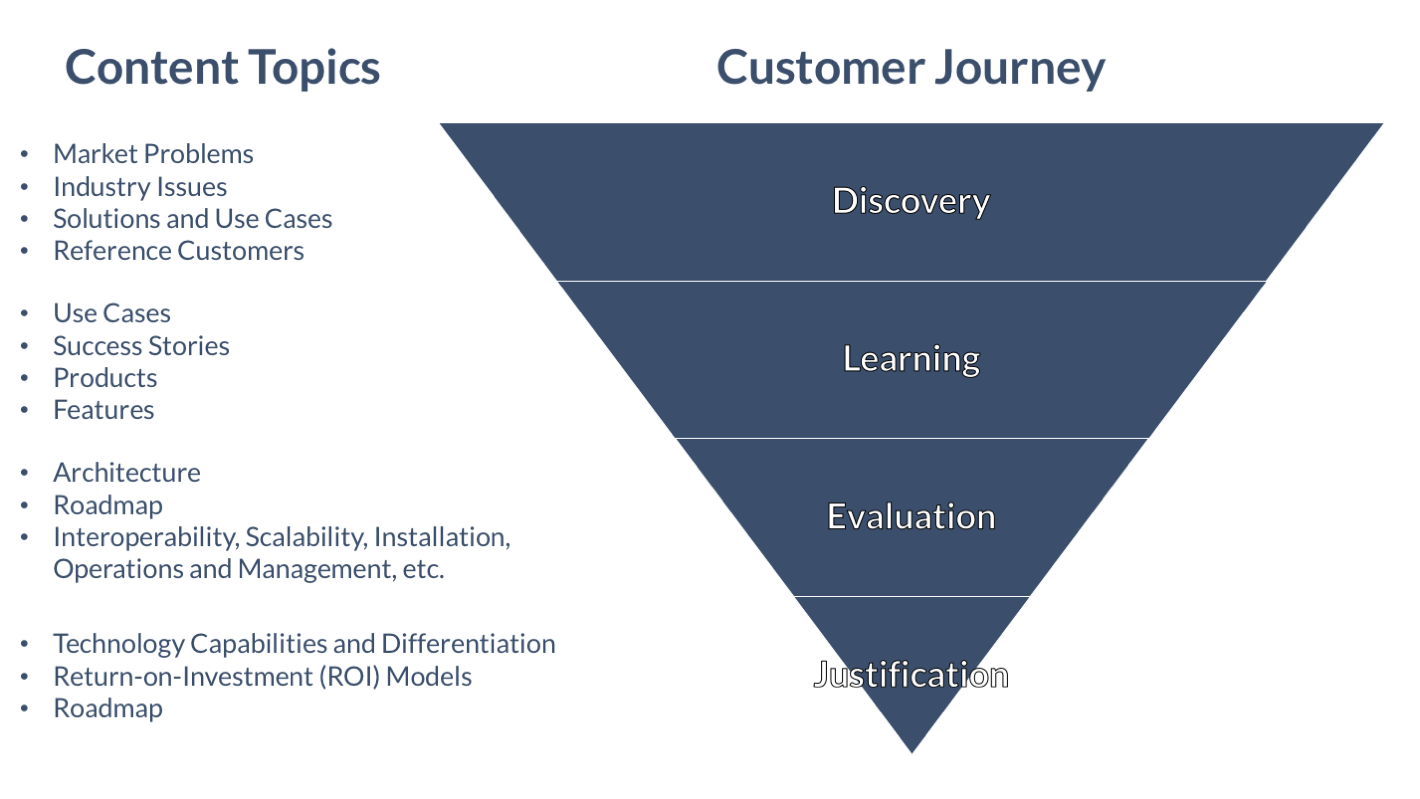Gain an edge over the competition by satisfying your customers’ information needs with rich content tailored to each stage of their buying cycles.
Content is the vehicle by which your messages get out into the market and in front of your target audiences, whether handed over by a salesperson, delivered in a presentation or webinar, downloaded from your website by a customer, or organically discovered by a new prospect searching for a solution to a problem.
A comprehensive content portfolio helps you get a prospect’s attention and guides them all the way through your sales funnel:
- Top-of-funnel content increases awareness and starts to build demand
- Middle-of-funnel content enables prospects to understand and evaluate your solutions
- Bottom-of-funnel content seals the deal and helps prospects justify their decisions
Ideally, your content anticipates and specifically addresses buying barriers at the precise stage in which they arise.

Moreover, a great content library substantially improves your search relevance, raises the bar versus the competition, and is vital to scaling up your sales and marketing efforts efficiently.
Cromulent has the technical and communications expertise to produce a range of content types to grow and extend your content library, including:
- Datasheets, infosheets, brochures, etc.: one-pagers, front-and-backs, four-pages-with-a-fold, full booklets, and so on – these formats are great for corporate overviews, product and platform information, success stories, and solution and use case messaging
- Long-form written content: from technology showcases and white papers to articles, case studies, and position papers
- Presentations: tell a simple story, like a quick corporate overview, or combine elements into a comprehensive message
- Web content: basically any written content to tell your story, show your value, etc., including website copy, blog posts, and news items
Plus, in addition to producing content, we can also help you define your overall content strategy.
Broadly, it’s helpful to consider content as belonging to one of three categories: foundational, compound, and specialty.
Foundational Content
Foundational content forms the atomic building blocks of your content portfolio. Each of these pieces focuses on a particular part of your message and adapts it into a written (e.g., document, web content) or presentation format.
Foundational pieces include:
- Corporate Overview material that tells your story and provides company facts
- Solution Overviews and associated Use Case Guides that demonstrate clearly what market problems you solve
- Product Overviews and deeper Product Guides that provide detailed information about how you solve market problems
- Platform Overviews and deeper Platform Guides that often take a more technical approach and address things like standards, interoperability, deployment models, scalability, and other specifications
- Technology Briefs that shine a spotlight on a particularly important piece of your solution
- Success Stories that provide evidence of your ability to solve problems in the real-world
Without having these basics in place, companies spin their wheels manually answering the same questions over and over, and customers grow frustrated that they can’t self-serve to quickly find answers to basic inquiries.
Compound Content
Compound content combines pieces and elements of foundational content into longer stories tailored for particular audiences, situations, and goals.
Examples of compound content include:
- Sales Presentations and Portfolio Brochures that introduce one or more problems and explain your unique solution capabilities
- Investor Presentations and Investor Brochures that highlight the financial opportunities (e.g., risk and reward, market growth, team qualifications, etc.) of investing in your company
- Keynote Presentations that take a higher-level view of a subject and generally seek to promote an idea or concept
Specialty Content
Specialty content takes a range of forms, but often exhibits one or both of two characteristics: going very deep into a particular subject and exploring a subject related to your domain.
Specialty content can include:
- Blog Content: for many companies – especially those relying on self-service discovery and purchase – blogs are a crucial element of an effective content strategy because they let you quickly grow a content library through commentary, updates, news, tidbits, tips and tricks, and much more
- Whitepapers: material that explores a problem or subject in general, in a very academic and objective manner, usually to build awareness and credibility in a domain
- Technical Showcases: material that explores your technological solution in detail, ideally relating it to considerations or requirements exposited in a related whitepaper
- Case Studies: deeper versions of the relatively lightweight Success Stories, that might include data analysis, ROI calculations, technical diagrams, etc.
- Position Papers: documents and presentations that explain your company’s position regarding some matter of importance (e.g., government regulation, a controversial or misunderstood industry subject, etc.)
- Research Programs: programs that explore aspects of your industry or market (e.g., analyzing trends over time, deep dives into particular subjects, etc.)
